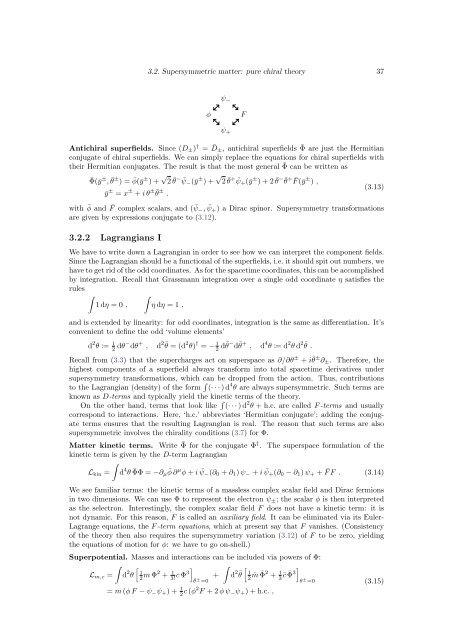The Bethe/Gauge Correspondence
The Bethe/Gauge Correspondence
The Bethe/Gauge Correspondence
Create successful ePaper yourself
Turn your PDF publications into a flip-book with our unique Google optimized e-Paper software.
3.2. Supersymmetric matter: pure chiral theory 37ψ −φFψ +Antichiral superfields. Since (D ± ) † = ¯D ± , antichiral superfields ¯Φ are just the Hermitianconjugate of chiral superfields. We can simply replace the equations for chiral superfields withtheir Hermitian conjugates. <strong>The</strong> result is that the most general ¯Φ can be written as¯Φ(ȳ ± , ¯θ ± ) = ¯φ(ȳ ± ) + √ 2 ¯θ − ¯ψ− (ȳ ± ) + √ 2 ¯θ + ¯ψ+ (ȳ ± ) + 2 ¯θ − ¯θ+ ¯F (ȳ ± ) ,ȳ ± = x ± + i θ ± ¯θ± .(3.13)with ¯φ and ¯F complex scalars, and ( ¯ψ − , ¯ψ + ) a Dirac spinor. Supersymmetry transformationsare given by expressions conjugate to (3.12).3.2.2 Lagrangians IWe have to write down a Lagrangian in order to see how we can interpret the component fields.Since the Lagrangian should be a functional of the superfields, i.e. it should spit out numbers, wehave to get rid of the odd coordinates. As for the spacetime coordinates, this can be accomplishedby integration. Recall that Grassmann integration over a single odd coordinate η satisfies therules ∫1 dη = 0 ,∫η dη = 1 ,and is extended by linearity: for odd coordinates, integration is the same as differentiation. It’sconvenient to define the odd ‘volume elements’d 2 θ := 1 2 dθ− dθ + , d 2 ¯θ = (d 2 θ) † = − 1 2 d¯θ − d¯θ + , d 4 θ := d 2 θ d 2 ¯θ .Recall from (3.3) that the supercharges act on superspace as ∂/∂θ ± + i¯θ ± ∂ ± . <strong>The</strong>refore, thehighest components of a superfield always transform into total spacetime derivatives undersupersymmetry transformations, which can be dropped from the action. Thus, contributionsto the Lagrangian (density) of the form ∫ (· · · ) d 4 θ are always supersymmetric. Such terms areknown as D-terms and typically yield the kinetic terms of the theory.On the other hand, terms that look like ∫ (· · · ) d 2 θ + h.c. are called F -terms and usuallycorrespond to interactions. Here, ‘h.c.’ abbreviates ‘Hermitian conjugate’; adding the conjugateterms ensures that the resulting Lagrangian is real. <strong>The</strong> reason that such terms are alsosupersymmetric involves the chirality conditions (3.7) for Φ.Matter kinetic terms. Write ¯Φ for the conjugate Φ † . <strong>The</strong> superspace formulation of thekinetic term is given by the D-term Lagrangian∫L kin = d 4 θ ¯ΦΦ = −∂ µ ¯φ ∂ µ φ + i ¯ψ − (∂ 0 + ∂ 1 ) ψ − + i ¯ψ + (∂ 0 − ∂ 1 ) ψ + + ¯F F . (3.14)We see familiar terms: the kinetic terms of a massless complex scalar field and Dirac fermionsin two dimensions. We can use Φ to represent the electron ψ ± ; the scalar φ is then interpretedas the selectron. Interestingly, the complex scalar field F does not have a kinetic term: it isnot dynamic. For this reason, F is called an auxiliary field. It can be eliminated via its Euler-Lagrange equations, the F -term equations, which at present say that F vanishes. (Consistencyof the theory then also requires the supersymmetry variation (3.12) of F to be zero, yieldingthe equations of motion for φ: we have to go on-shell.)Superpotential. Masses and interactions can be included via powers of Φ:∫ [∫ [L m,c = d 2 1θ2 m Φ2 + 1 3! c + d 2 1 ¯θΦ3]¯θ± 2 ¯m ¯Φ 2 + 1 3 ¯c ¯Φ 3]=0θ ± =0= m (φ F − ψ − ψ + ) + 1 2 c (φ2 F + 2 φ ψ − ψ + ) + h.c. ,(3.15)
















